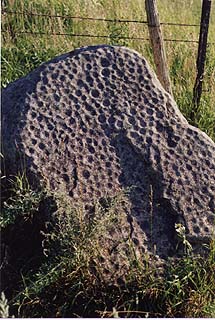This is a cup marked granite boulder located on the "The Blood Run" archaeological site in Iowa, USA. The site once contained an extensive complex of burial mounds, stone circles, village areas, and an enclosure...
According to "The Cupmarked Boulders of Blood Run, Iowa" and "Ethnographic Analogy and the Folklore of Cup and Ring Rock Art" by Kevin L. Callahan, Department of Anthropology, University of Minnesota, this stone is one of the so called "death stones"...Death stones? Could this be in any way related to what I wrote about the in this post, "Lapis manalis", about "Blessed dead stone"?
Of course it is 🙂
Here is what Kevin says (paraphrased): "We examined the pitted boulders and nearby burial mounds at Blood Run, Iowa and Fort Ransom, North Dakota and we reviewed the ethnohistoric sources of historic period Plains Indians, and Indians from the Far West"...
"The data suggests the possibility that the primary social function of these cup marked boulders may have been as “death stones” to mark each new death or burial"...
Very very interesting, right?
Kevin then says: "Such sacred stones were not considered inanimate objects, but the occasional dwelling place of spirits, and may have had related functions as a place for contacting the spirit world, vision questing, and as “baby rocks” for couples wishing to conceive"...
Ahh, so they believed that spirits lived in stones...Interesting...But what does this have to do with Old European culture? Well, a lot. In my post, "Lapis manalis", I wrote that Slavs believed that stones can "capture" souls of the deceased, who then continued to live in them...
Today, I came across this paper: "Portals to Other Realms: Cup-Marked Stones & Prehistoric Rock Carvings" by Gary Varner. And in it I found this being said about cup marked stones and the dead:
"The link to the dead is illustrated also in Swedish folklore which refers to cup-marked stones as “elfstenar.” Elfs are believed to be the souls of the dead who frequent, if not live in or below the stones"...
"The cups are often used for offerings to ensure that the elfs are not offended or their peace disturbed...Some of these gifts were rag-dolls left by women who wished to become pregnant"...🙂
"One cup-marked stone on Seil island...Scotland, has been used into contemporary times to appease the “wee folk”. Each spring the cup is filled with milk in the belief that if it wasn’t, the Little People would ensure that the cows did not produce any milk in the summer"...
Drought causing spirits who live in stones? Interesting, really interesting...In Finland these cup marked "sacrificial stones" were used to pour the first cows milk or first grain harvested as an offering to the spirits living in the stone...And they were offered first fruits? 🙂
"In Estonia as well 'offering stones' were used to mark the passing of people: "a close relative of each dead person had an obligation to bore a hole in the offering stone"...
"A large number of ancient cup-marked stone sites in the UK are associated with cremations, tombs and burials...Like Witton Gilbert cist burials near Durham City in the UK"...
"One of these cists, which dates to the Early Bronze Age (2300 BCE to 1500BCE), was covered by a slab of sandstone which was decorated on one side with cups and rings and on the other with only cups"...
"The current theory is that cup-marked stones, often associated with burials, resulted from the introduction of farming in Europe and the UK and may have been part of fertility rites and sacrificial offerings to the dead as a part of ancestor worship"...
But also with fertility...Interesting, and not at all surprising, considering the ancient belief that the fertility of the people, animals and the land is the gift of the dead...I wrote about this in my post, "Lapis manalis"...
Anyway, very interesting indeed...
PS: In this old article, "Rebirth", I proposed that the cup and ring mark cut into this Bronze Age tomb in Ireland, and illuminated every equinox, represented rebirth of the sun, solar year, which was then linked to the rebirth of the people buried in the tomb...



No comments:
Post a Comment